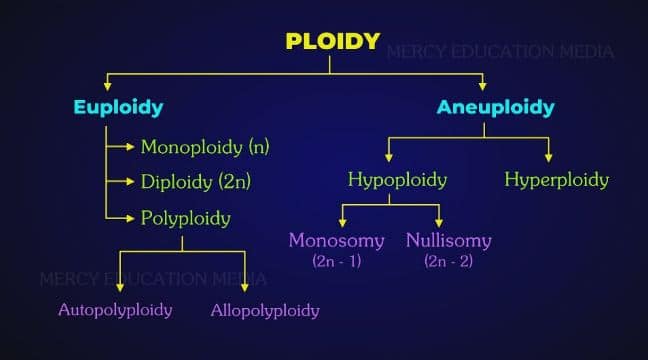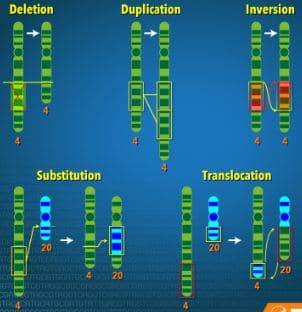Chromosomal Aberration: Definition, Types and Examples
Definition
Chromosomal Aberration or Chromosomal abnormalities occur when there is a defect in the number of chromosomes in a cell of an organism or in the arrangement of genetic material (Genes) on the chromosome. Chromosomal abnormalities give rise to specific physical symptoms, however, the severity of these depends on the type of aberration.

Abnormalities may be in the form of additional material attached to a chromosome, or a whole chromosome is missing, or even in the faulty formation of a chromosome. Any increase or decrease in the chromosomal material interferes with normal development and function. Normally, a human cell has 23 pairs of chromosomes, making 46 in total. Any abnormality in the structure of chromosomes or in the number of chromosomes leads to the chromosomal aberration.
The term “karyotype” refers to the full set of chromosomes from an individual. Abnormalities in chromosomes are detected or confirmed by karyotype comparison of a given genome to a “normal” karyotype for the species through genetic testing. Chromosome abnormalities usually occur when there is an error in cell division following meiosis or mitosis.
Major types of Chromosomal Aberration1
There are two main types of chromosomal Aberration that can occur during meiosis and fertilization.
- Numerical Aberrations
- Structural aberrations

A- Numerical Aberrations
Numerical aberrations are generally caused by a failure in chromosome division during meiosis that results in gametic cells with an extra chromosome or a deficiency in the number of chromosomes. Variation in chromosome number involves
1) addition or loss of one or more chromosomes (Aneuploidy)
2) addition or loss of one or more haploid sets of chromosomes (Euploidy)
1- Aneuploidy ( Greek, aneu= uneven, ploids= units)
When an organism gains or loses one or more chromosomes, but not a complete set, this condition is called aneuploidy. It leads to the variation in the number of chromosomes but not involves the whole set of chromosomes. The nuclei of aneuploids contain chromosomes whose number is not the true multiple of basic number (n).
Examples: are Down syndrome (which has 47 chromosomes instead of 46) and Turner syndrome (45 chromosomes instead of 46). Here the number of chromosomes in the individual is not a true multiple of basic number n (n=23).
Type of aneuploidy
i. Monosomy: The loss of one chromosome produces a monosomic (2n-1) and the condition is known as monosomy. Its example is Turner syndrome (2n-1 = 45 chromosomes in humans)
ii. Trisomy: The gain of one extra chromosome produces trisomic (2n+1) and the condition is called trisomy. Example are
- Down syndrome (2n+1= 47 chromosomes in humans).
- Trisomy 18 (Edwards syndrome) have an additional copy of chromosome 18
- Trisomy 13 (Patau syndrome) have an additional copy of chromosome 13
- Trisomy 8 (Warkany syndrome 2) have an additional copy of chromosome 8
iii. Tetrasomy: The gain of two extra chromosomes produces tetrasomic (2n+2) individuals and the condition is called Tetrasomy. Examples are
- XXXY syndrome (Klinefelter’s syndrome)
- XXXX syndrome ( 48 chromosomes)
- XXYY syndrome ( 48 chromosomes)
iv. Pentasomy: The gain of three extra chromosomes produces pentasomic (2n+3) individuals and the condition is called Pentasomy.
Example:
Penta X Syndrome: (49, XXXXX), female has five X chromosomes instead of the normal two. Signs are intellectual disability, short height, less muscle tone, and delay in development.
V. Nullisomy: It is a condition in which a pair of homologous chromosomes is completely lost. ( 2n-2). Humans with this disorder will not survive.
Example2: About 21 nullisomics of the allohexaploid Triticum aestivum have been made, they differ in appearance from normal hexaploids and are have less vigor.
2- Euploidy ( Greek, ae= even or true, ploids= units)
When one or more complete haploid set of chromosomes are involved in the aberration, the resulting abnormality is called Euploidy. It is more tolerated in plants rather than animals. For example, if there is a human cell that has an extra set of 23 chromosomes it will have Euploidy.
Types of Euploidy
Ploidy refers to the number of homologous sets of chromosomes in the genome of a cell or an organism. Each set is designated by n.
i- Monoploidy:
Monoploidy: The state of having a single set of chromosomes is called monoploidy and is represented by 1n. The cell or organism with a single set of chromosomes is called a monoploid. Monoploidy is lethal in animals but in the case of plant species, this can be more tolerated.
In most animal species this could mean death but there are few animal species where monoploidy is a normal part of the life cycle, such as male wasps, ants, and bees. The offsprings that have arisen from monoploidy are those that have developed from unfertilized eggs.
ii- polyploidy:
The condition in which a normally diploid cell or organism acquires one or more additional sets of chromosomes is called polyploidy. In other words, the polyploid cell or organism has three or more times the number of haploid chromosomes. Polyploidy arises as a result of the total nondisjunction of the chromosomes during mitosis or meiosis.
Polyploidy in plants:
Polyploidy is common among plants and has, in fact, been an important source of speciation in angiosperms. Particularly important is allopolyploidy, which involves the duplication of chromosomes in a hybrid plant.
Typically, a diploid hybrid is sterile because it does not have the homologous chromosome pairs necessary for successful gamete formation during meiosis. However, in the case of tetra polyploids, the plant duplicates the set of chromosomes inherited from each parent, meiosis can occur, because each chromosome will have a homolog derived from its duplicate set. Thus, Tetrapolyploidy confers fertility on the previously sterile hybrid, which therefore attains the status of a complete species distinct from either parent.
Up to half of the known angiosperm species have been estimated to have arisen through polyploidy, including some of the species most prized by man. Plant breeders use this process, treating desirable hybrids with chemicals, such as colchicine, which are known to induce polyploidy.
Polyploid animals are much less common, and the process appears to have had little effect on animal speciation.
B- Structural aberrations
These occur due to a loss of genetic material, or a reorganization in the location of the genetic material. They include deletions, duplications, inversions, ring formations, and translocations.
Unbalanced rearrangements include deletions, duplications, or insertions of a chromosomal segment. Balanced rearrangements include inverted or translocated chromosomal regions. Since the full complement of DNA material is still present, balanced chromosomal rearrangements can go unnoticed because they may not cause disease.3
The disease can arise as a result of a balanced rearrangement if breaks in the chromosomes occur in one gene, resulting in a missing or non-functional protein, or if the fusion of chromosomal segments results in a hybrid of two genes, producing a new protein product whose function is detrimental to the cell.3

Types of structural aberrations
Deletions: A part of the chromosome is missing or removed. Known disorders include Wolf-Hirschhorn syndrome, which is caused by partial removal of the short arm from chromosome 4; and Jacobsen syndrome, also called 11q terminal deletion disorder, caused by the terminal removal of the q arm of chromosome 11.
Duplications: A part of the chromosome is duplicated, resulting in additional genetic material. Known disorders include Charcot-Marie-Tooth disease type 1A, which can be caused by duplication of the gene encoding peripheral myelin protein 22 (PMP22) on chromosome 17.
Translocations: When a part of a chromosome is transferred to another chromosome. There are two main types of translocations.
- In a reciprocal translocation, segments of two different chromosomes have been exchanged.
- In a Robertsonian translocation, one complete chromosome has joined another in the centromere; These only occur with chromosomes 13, 14, 15, 21, and 22.
Inversions: a part of the chromosome has been broken, upside down, and reattached, therefore, the genetic material is inverted.
Insertions: A portion of one chromosome has been deleted from its normal place and inserted into another chromosome.
Rings: Ring chromosomes can result when one chromosome undergoes two breaks and the broken ends are fused into a circular chromosome. This can happen with or without loss of genetic material.
Isochromosome: An isochromosome can form when one arm of the chromosome is missing and the remaining arm is duplicated.
How chromosomal aberrations or abnormalities occur?
Chromosomal abnormalities can occur as an accident when the egg or sperm forms or during the early stages of fetus development. The mother’s age and certain environmental factors may play a role in the occurrence of genetic errors.
Most chromosomal abnormalities occur as an accident in the egg or sperm and are therefore not inherited. The abnormality is present in all cells of the body; however, some abnormalities can occur after conception, resulting in mosaicism (where some cells have the abnormality and others do not).
Prenatal exams and tests can be done to examine the fetus’s chromosomes and detect some, but not all, types of chromosomal abnormalities.
